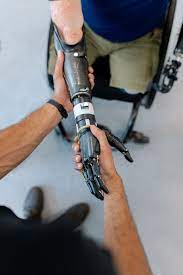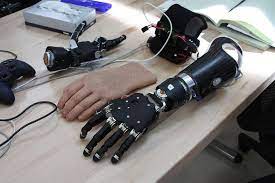Could Prosthetics Be Controlled by the Brain?

October 30, 2021
It sounds like something out of a science fiction movie, but it is possible to create artificial limbs that respond to neural signals. Not only that, these prosthetics can possess the capacity to feel and sense differences between objects in an environment. So how is this all possible, and what could this mean for the general public?
Currently, bionic limbs with such characteristics are usually for the arm, which provides a greater capacity for testing the sensory aspects of this technology. As humans, we use our hands for many tasks. Most of the time we are unconscious about how often we take in sensory input and complete day-to-day tasks our hands, but their usefulness makes hands are the perfect target for testing prosthetic limbs. Patients using such artificial limbs would garner the most opportunities to test the technology through their everyday activities, and any flaws could be caught early and resolved.

The technology behind the limb involves anchoring the prosthetic to the skeleton of the involved area (in most cases, where the forearm would begin). The overall sensation of touch (including pressure, texture, etc.) comes from implanting electrodes in the muscle and nerves of the intact portion of the arm. These electrodes are capable of sending signals both up and down the arm, much like the nerve signals a biological hand would receive. This allows for both control and touch, as a patient can send nerve signals from the brain for movement and also receive sensory input from the artificial limb.
The overall impact this technology could have is absolutely incredible. While current prosthetics assist in functionality, such as with a prosthetic leg aiding in mobility, artificial limbs have never been able to attain such likeness to a biological limb. It is easy to create an artificial limb that looks like its biological counterpart, but it is much more difficult to create a prosthetic that possesses similar qualities and capabilities to the biological one. Adding to this, the current models do not require any sort of battery or bulky equipment, as one might think. They also show promise in longevity, as they have not required much professional maintenance in their trial phases. They are not confined to research labs or controlled environments, and they have been safely used in day-to-day life with the patients so far.
 While some aspects need to be researched and developed further, the progress in such technology so far presents great promise for the world of artificial limbs. Currently, this technology is only being explored in a few places (with Sweden being the country with the most notable contributions). However, there is hope to further develop such models for other limbs and make the technology accessible to the general public, completely revolutionizing the world of both engineering and medicine.
While some aspects need to be researched and developed further, the progress in such technology so far presents great promise for the world of artificial limbs. Currently, this technology is only being explored in a few places (with Sweden being the country with the most notable contributions). However, there is hope to further develop such models for other limbs and make the technology accessible to the general public, completely revolutionizing the world of both engineering and medicine.
Works Cited
“Can the brain recognise artificial limbs as real ones? New study reveals it can.” CORDIS, cordis.europa.eu/article/id/123566-can-the-brain-recognise-artificial-limbs-as-real-ones-new-study-reveals-it-can. Accessed 24 Oct. 2021.
Chalmers University of Technology. “Mind-controlled arm prostheses that ‘feel’ are now a part of everyday life.” ScienceDaily. ScienceDaily, 30 April 2020. <www.sciencedaily.com/releases/2020/04/200430110321.htm>.
Rigby, Sara. “Thought-controlled bionic arm with sense of touch ‘could be available in two years.'” Science Focus, 30 Apr. 2020, www.sciencefocus.com/news/thought-controlled-bionic-arm-with-sense-of-touch-could-be-available-in-two-years/. Accessed 24 Oct. 2021.
